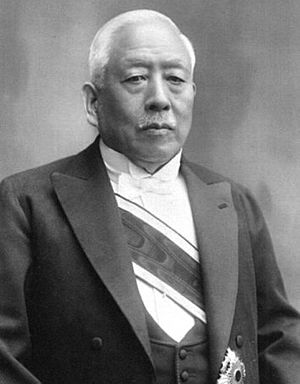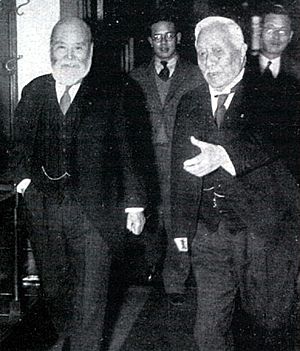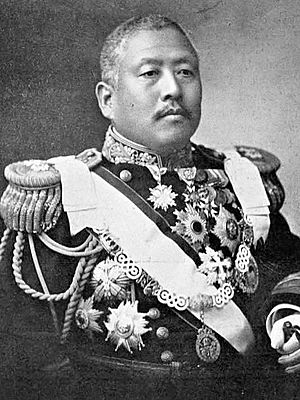Saitō Makoto facts for kids
Quick facts for kids
Saitō Makoto
|
|
|---|---|
| 斎藤 実 | |
 |
|
| Lord Keeper of the Privy Seal of Japan | |
| In office 26 February 1935 – 26 February 1936 |
|
| Monarch | Shōwa |
| Preceded by | Makino Nobuaki |
| Succeeded by | Ichiki Kitokurō |
| Prime Minister of Japan | |
| In office 26 May 1932 – 8 July 1934 |
|
| Monarch | Shōwa |
| Preceded by | Korekiyo Takahashi (Acting) |
| Succeeded by | Keisuke Okada |
| Governor-General of Korea | |
| In office 17 August 1929 – 17 June 1931 |
|
| Monarch | Shōwa |
| Preceded by | Hanzō Yamanashi |
| Succeeded by | Kazushige Ugaki |
| In office 1 December 1927 – 10 December 1927 |
|
| Monarch | Shōwa |
| Preceded by | Kazushige Ugaki (Acting) |
| Succeeded by | Hanzō Yamanashi |
| In office 12 August 1919 – 14 April 1927 |
|
| Monarch | Taishō Shōwa |
| Preceded by | Yoshimichi Hasegawa |
| Succeeded by | Kazushige Ugaki(Acting) |
| Minister of the Navy | |
| In office 7 January 1906 – 16 April 1914 |
|
| Prime Minister | Saionji Kinmochi Katsura Tarō Yamamoto Gonnohyōe |
| Preceded by | Yamamoto Gonnohyōe |
| Succeeded by | Yashiro Rokurō |
| Personal details | |
| Born | 27 October 1858 Mizusawa Domain, Mutsu Province, Japan |
| Died | 26 February 1936 (aged 77) Tokyo, Japan |
| Political party | Independent |
| Spouse | Saitō Haruko (1873–1971) |
| Alma mater | Imperial Japanese Naval Academy |
| Awards | Order of the Chrysanthemum Order of the Bath (Honorary Knight Grand Cross) |
| Signature |  |
| Military service | |
| Allegiance | |
| Branch/service | |
| Years of service | 1879–1928 |
| Rank | |
| Commands | Akitsushima Itsukushima |
| Battles/wars | First Sino-Japanese War Russo-Japanese War World War I |
Viscount Saitō Makoto, GCB (斎藤 実, 27 October 1858 – 26 February 1936) was a Japanese naval officer and politician. Upon distinguishing himself during his command of two cruisers in the First Sino-Japanese War, Saitō rose rapidly to the rank of rear admiral by 1900. He was promoted to vice admiral during the Russo-Japanese War in 1904. After serving as Minister of the Navy from 1906 to 1914, Saitō held the position of Governor-General of Korea from 1919 to 1927 and again from 1929 to 1931. When Inukai Tsuyoshi was assassinated in May 1932, he took his place as prime minister and served one term in office. Saitō returned to public service as Lord Keeper of the Privy Seal in February 1935 but was assassinated only a year later during the February 26 Incident. Saitō along with Takahashi Korekiyo were the last former prime ministers of Japan to be assassinated until 2022, with the assassination of Shinzo Abe.
Contents
Early life

Saitō was born in Mizusawa Domain, Mutsu Province (part of present-day Ōshū City Iwate Prefecture), as the son of a samurai of the Mizusawa Clan. In 1879, he graduated from the 6th class Imperial Japanese Naval Academy, ranking third out of a class of 17 cadets. He was commissioned an ensign on September 8, 1882, and promoted to sub-lieutenant on February 25, 1884.
Military career
In 1884, Saitō went to the United States for four years to study as a military attaché. Promoted to lieutenant on July 14, 1886; in 1888, after returning to Japan, he served as a member of the Imperial Japanese Navy General Staff.
After his promotion to lieutenant commander on December 20, 1893, he served as executive officer on the cruiser Izumi and battleship Fuji.
During the First Sino-Japanese War, Saitō served as captain of the cruisers Akitsushima and Itsukushima. He received rapid promotions to commander on December 1, 1897 and to captain on December 27. On November 10, 1898, he became Vice Minister of the Navy, and was promoted to rear admiral on May 20, 1900
Political career
Saitō was again Vice Navy Minister at the start of the Russo-Japanese War. He was promoted to vice admiral on June 6, 1904. He was awarded the Order of the Rising Sun (1st class) in 1906. After the end of the war, he served as Navy Minister for 8 years, from 1906 to 1914, during which time he continually strove for expansion of the navy.
On September 21, 1907, Saitō was ennobled with the title of danshaku (baron) under the kazoku peerage system. On October 16, 1912, he was promoted to full admiral. However, on April 16, 1914, Saitō was forced to resign from his post as Navy Minister due implications of his involvement in the Siemens scandal, and officially entered the reserves.
In September 1919, Saitō was appointed as the third Japanese Governor-General of Korea. Rising to the post right after the culmination of the Korean independence movement, he was subject to an immediate assassination attempt by Kang Woo-kyu, a radical Korean nationalist. He served as governor-general of Korea twice—in 1919–1927, and again in 1929–1931, implementing a series of measures to moderate Japan's policies on Koreans. He was awarded the Order of the Paulownia Flowers in 1924. On April 29, 1925, his title was elevated to that of shishaku (viscount).
In 1927, Saitō was a member of the Japanese delegation at the Geneva Naval Conference on Disarmament, and he later became a privy councillor.
Prime Minister
Following the assassination of Prime Minister Inukai Tsuyoshi on May 15, 1932 by fanatical navy officers who thought Inukai far too conciliatory (the May 15 Incident), Prince Saionji Kinmochi, one of the Emperor's closest and strongest advisors, attempted to stop the slide towards a military take-over of the government. In a compromise move, Saitō was chosen to be Inukai's successor. Sadao Araki remained as War Minister and immediately began making demands on the new government. During Saitō's tenure, Japan recognized the independence of Manchukuo, and withdrew from the League of Nations.
Saitō's administration was one of the longer-serving ones of the inter-war period, and it continued until July 8, 1934, when the cabinet resigned en masse because of the Teijin Incident bribery scandal. Keisuke Okada succeeded as prime minister.
Saitō continued to be an important figure in politics as Lord Keeper of the Privy Seal from December 26, 1935, but was assassinated during the February 26 Incident of 1936 at his home in Yotsuya, Tokyo. Takahashi, his predecessor, was shot dead the same day, along with several other top-rank politicians targeted by the rebels.
Saitō was posthumously awarded the Supreme Order of the Chrysanthemum.
Honours
From the corresponding article in the Japanese Wikipedia
Peerages
- Baron (21 September 1907)
- Viscount (9 April 1925)
Decorations
- Order of the Sacred Treasure, Fourth Class (20 June 1899; Fifth Class: 25 November 1896; Sixth Class: 26 May 1893)
- Order of the Golden Kite, Second Class (1 April 1906; Fourth Class: 23 May 1896)
- Grand Cordon of the Order of the Rising Sun (1 April 1906; Second Class: 27 December 1901; Sixth Class: 23 May 1896)
- Grand Cordon of the Order of the Rising Sun with Paulownia Flowers (11 February 1924)
- Grand Cordon of the Order of the Chrysanthemum (26 February 1936; posthumous)
Foreign decorations
 United Kingdom: Honorary Knight Grand Cross of the Order of the Bath (GCB) (15 May 1906)
United Kingdom: Honorary Knight Grand Cross of the Order of the Bath (GCB) (15 May 1906) Kingdom of Prussia: Order of the Red Eagle, Knight 1st Class (26 February 1907)
Kingdom of Prussia: Order of the Red Eagle, Knight 1st Class (26 February 1907) Kingdom of Italy: Knight Grand Class of the Order of Saints Maurice and Lazarus (1 July 1907)
Kingdom of Italy: Knight Grand Class of the Order of Saints Maurice and Lazarus (1 July 1907) France: Grand Officer of the Legion d'Honneur (17 December 1907; Commander: 4 April 1901)
France: Grand Officer of the Legion d'Honneur (17 December 1907; Commander: 4 April 1901) Netherlands: Knight Grand Cross of the Order of Orange-Nassau (31 May 1911)
Netherlands: Knight Grand Cross of the Order of Orange-Nassau (31 May 1911) Holy See:
Holy See:
- Knight Grand Cross of the Order of St. Sylvester (17 January 1922)
- Knight Grand Cross of the Order of Pius IX (23 January 1932)
See also
 In Spanish: Saitō Makoto para niños
In Spanish: Saitō Makoto para niños


